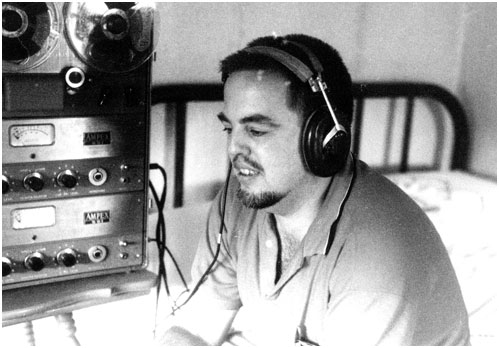folklorist alan lomax
By the time Alan Lomax turned twenty, he had travelled the south with Zora Neale Hurston, and recorded Lead Belly Ledbetter in Angola Prison. Later he championed Woody Guthrie and Jelly Roll Morton, and organized Greenwich Village folk parties that influenced Bob Dylan. His life was dedicated to recording and studying American folk music for the Library of Congress and as a
result, some would say he changed the country's attitude toward its indigenous culture. The following are just a few details of his long career.
Alan Lomax was born January 31, 1915, in Austin, TX; Lomax was the third of four children born to John Avery (a curator for the Library of Congress) and Bess (Brown) Lomax . He began his work in folklore as a teenager, traveling with his folklorist father through the byways of the American South, hauling a five-hundred-pound recording machine.
result, some would say he changed the country's attitude toward its indigenous culture. The following are just a few details of his long career.
Alan Lomax was born January 31, 1915, in Austin, TX; Lomax was the third of four children born to John Avery (a curator for the Library of Congress) and Bess (Brown) Lomax . He began his work in folklore as a teenager, traveling with his folklorist father through the byways of the American South, hauling a five-hundred-pound recording machine.
Trunk of car with recording equipment
(Library of Congress, American
Folklife Center)

In 1928 the Library of Congress established the Archive of American Folk Song. John Lomax was appointed curator of the collection in 1932, and Alan took a leave from college to assist his father’s collection work. He completed his studies in 1936, when he graduated with a B.A. summa cum laude from the University of Texas at Austin. John and Alan Lomax coauthored American Ballads and Folk Songs in 1934.
In 1936 Alan married Elizabeth Lyttleton Harold, and while they honeymooned in Haiti, they documented that island’s
vodun musical tradition. Alan Lomax succeeded his father as curator of the Archive of American Folk Song, and in 1939 he began broadcasting his own segment, called “Wellsprings of Music,” for the School of the Air radio series for the Columbia Broadcasting
System (CBS).
From 1932 until 1942, Alan Lomax; his stepmother, Ruby Terrill Lomax; and his father, John, published more than three thousand discs of indigenous music from forty-seven of the forty-eight states, as well as Haiti, Canada, and the Bahamas.
Lomax advocated what he called “cultural equity: the right of every culture to have equal time on the air and equal time in the classroom.” He believed that sound recording could greatly empower folk musicians and their audiences by giving “a voice to the voiceless … [putting] neglected cultures and silenced people into the communications chain.”
From 1950 to 1958 Lomax collected and recorded in Europe. As a result he avoided the possibility of being blacklisted by Senator Joseph McCarthy’s House Un-American Activities Committee.
In 1962 he recorded throughout the Caribbean, including the Hindu chaupai communities in Trinidad and African garifuna colonies in Guatemala. This trip was intended to establish the similarities of many cultures with the goal of a Unified West Indies.
Lomax's collection of sound recordings, motion picture recordings, photographs, journals, field notes, and other material was acquired by the Library of Congress in 2004.
You can read more about the collection here:
http://www.loc.gov/folklife/lomax/

